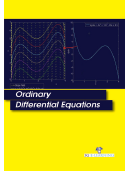Mathematics

An ordinary di erential equation (ODE) is an equation that involves some ordinary derivatives (as opposed to
partial derivatives) of a function. Di erential equations are essential for a mathematical description of nature,
because they are the central part many physical theories. A few examples are Newton’s and Lagrange equations for classical mechanics, Maxwell’s equations for classical electromagnetism, Schrodinger’s equation for quantum mechanics, and Einstein’s equation for the general theory of gravitation. Therefore, an ordinary di erential
equation (ODE) is a di erential equation containing one or more functions of one independent variable and its
derivatives. The term ordinary is used in contrast with the term partial di erential equation which may be with
respect to more than one independent variable. ODEs that are linear di erential equations have exact closed-form solutions that can be added and multiplied by coe cients. By contrast, ODEs that lack additive
solutions are nonlinear, and solving them is far more intricate, as one can rarely represent them by elementary functions in closed form: Instead, exact and analytic solutions of ODEs are in series or integral form. Graphical and numerical methods, applied by hand or by computer, may approximate solutions of ODEs and perhaps yield useful information, often su cing in the absence of exact, analytic solutions.